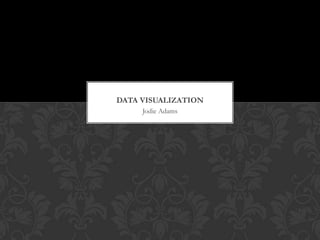201
- 1. DATA VISUALIZATION Jodie Adams
- 2. SUMMARY My project will look at different types of data visualisations and determent, which is more popular. It will take data from a Facebook group called âInformation Aestheticsâ which is linked to blog where people post links to their visualisations they have made. I will determine which visualisation are the most popular by how many likes, comments and shares each of them have. I will display the information I have found in a visualisation.
- 5. FACEBOOK GRAPH API EXPLORER
- 6. SCIENTIFIC VISUALISATION âThere is the very basic type of visualisation, this includes things like charts and simple diagrams. These are mostly used in teaching or when presenting statistics.â Fields, A (2009) discovering statistics using SPSS. 3rd edition. London: SAGE publishing Ltd
- 7. THE MIDDLE VISUALISATION âThe next type of visualisation uses both writing and pictures to get the information across. This is a more common form of visualisation, we see this in our day-to-day lives. It is used for such things as maps, the weather, more complicated diagrams and to show trendsâ Mosher, D. (2011) âData as Art: 10 Striking Science Mapsâ Wired Science, 8th March. Available at http://www.wired.com/wiredscience/2011/03/best-science-maps/?pid=1052 (accessed: 24th November 2011)
- 8. ARTISTIC VISUALISATION âThe last type of data visualisation is used for artistic purposes. These tend to be pictures that use data to create them, even though looking at the end result it is not possible to tell that data was the reason for the artwork.â Reichardt. A (1971) The computer in art. London: Studio Visia Limt RÃķmhild, C. & Harrison, C. (2007) Bible Cross-References. Available at http://www.chrisharrison.net/index.php/Visualizations/BibleViz (accessed: 24th November 2011)
- 9. TIMETABLE
- 11. MIDDLE VISUALISATION OUTCOME
- 12. ARTISTIC OUTCOME
- 13. RELATIONSHIP THEME CNN's Ecosphere (2011) CNN Ecosphere: 3D Ecosystem Globe Grows on #cop17 Tweets. Available at http://infosthetics.com/archives/2011/11/cnn_ ecosphere.html (accessed: 24th November 2011)
- 14. ANALYSIS AND PROBLEM SOLVING
- 15. RESEARCH AND CRITICAL CONTEXT
- 16. REALIZATION
- 18. INTEGRATION OF TECHNICAL, CREATIVE AND CONTEXTUAL SKILLS
- 19. THANK YOU Presentation by Jodie Adams Thank you for listening Any Questions



















